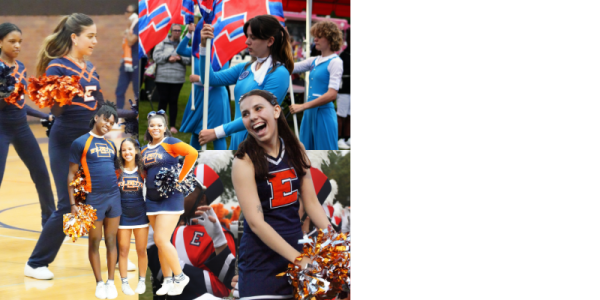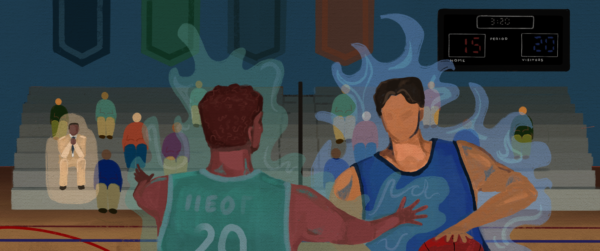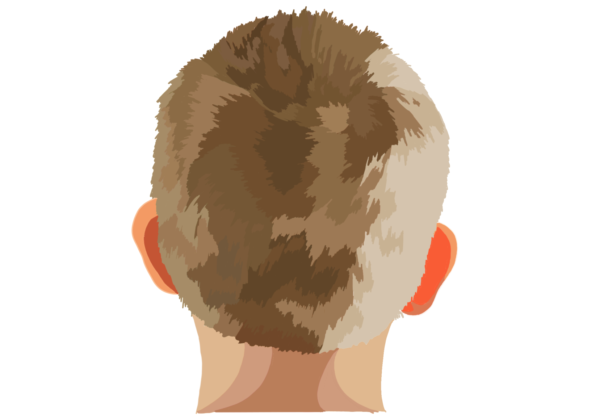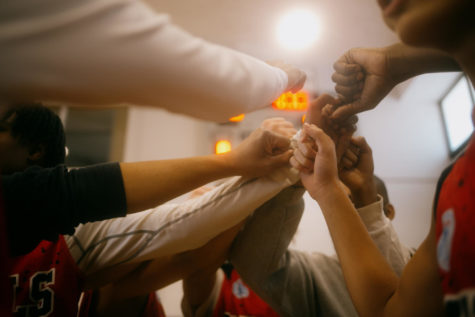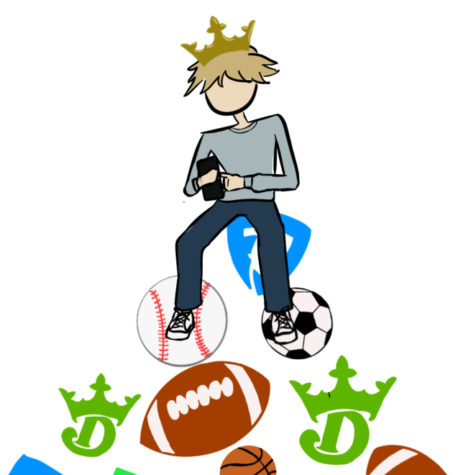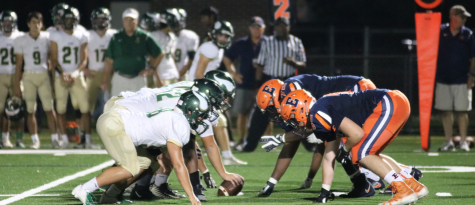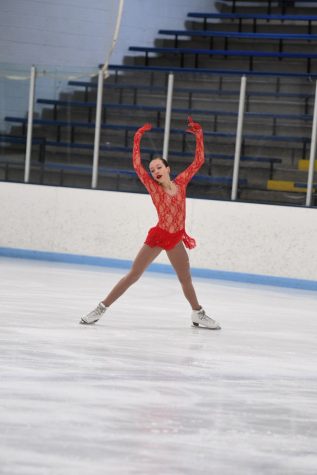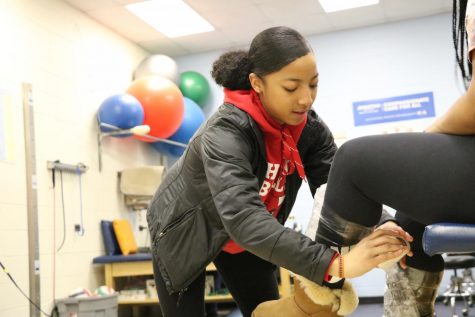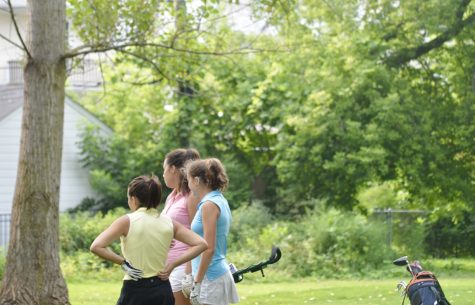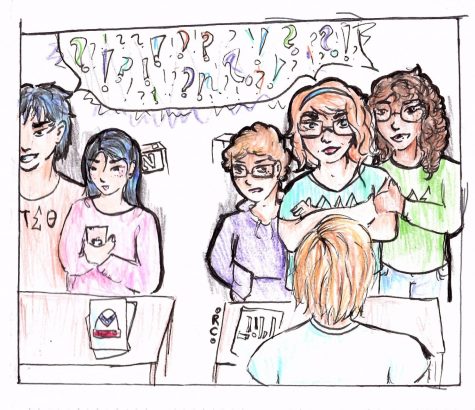Same game, different representation
December 26, 2018
2018 marks the 46th anniversary of Title IX — the law that prohibits sex-based discrimination in federally funded programs or activities, including school sports. Since Title IX passed, the number of women participating in sports has skyrocketed. Yet still, worldwide, men dominate the sports industry. On average, women athletes are paid less than male athletes, women’s sports receive less coverage than men’s and feminine stereotypes continue to counter athleticism. At ETHS, even with an administration and student body that publicly advocate for gender equality, girls sports still receive less supporters and representation than boys sports.
Women Athletes Face Sexist Fan Culture
For many sports at ETHS, a contrast exists between the number of people in the crowds at girls games and boys games. This disparity is especially evident between girls and boys basketball. At their most recent home game, the attendance for girls basketball was under 250, whereas boys basketball home games typically fill almost every one of Beardsley Gym’s 2,400 seats.
Athletic Director Chris Livatino confirms that the only time girls basketball has sold out a game is “when we’ve had double-headers with boys basketball versus New Trier.”
Girls varsity basketball player and junior Kayla Henning says, “It is hard to call it anything else but subconscious sexism when a student’s entire mindset shifts on the excitement of attending a game by the simple addition of the word ‘girls.’”
Of all of the varsity girls athletes interviewed by The Evanstonian, all nine confirmed that there is a visible lack of support at their games in comparison to boys teams. Girls varsity lacrosse player and junior Julia English believes that the low turnout at girls games is because of the lack of advertising of girls sports in mainstream media.
“Not enough awareness is put out about ETHS girls sports, so people do not come to support us; girls sports are taken way less seriously,” English says.
In past years, the @ETHSports Twitter account highlighted boys sports and male athletes disproportionately to girls sports and female athletes. Last November, it retweeted 71 more posts about male athletes, particularly football players, who have received offers from colleges than female athletes who have received offers.
“I tend to tweet about the sports that are having more success because there is more stuff written about them; there is more hype and excitement about those teams,” Livatino says.
Historically, sports such as football and basketball have been boys sports and have received high levels of media coverage and hype from fans. There are no sports typically played by girls that receive equivalent levels of recognition. This nationwide emphasis on boys football and basketball directly translates to ETHS athletics, as these sports are highly publicized — not only through the @ETHSports Twitter account, but also through acts such as the parade for boys basketball last year after they advanced to State. Girls swimming, girls tennis, boys golf and boys track all had representatives who placed at their respective State competitions, but did not receive a parade.
“The @ETHSports Twitter does retweet from all the sports’ individual Twitter pages, but disproportionately tweets about football and basketball games, with few tweets about any other sports. This uneven support for the ‘primetime sports’ is not only detrimental to girls sports, but to ‘non-primetime’ boys sports as well,” girls varsity soccer player and junior Sylvi Imrem says.
While the lack of representation of girls sports is a large societal and cultural issue, some students say that ETHS is perpetuating this culture.
“When coaches and our Athletic Department are constantly encouraging this culture of just going to boys sports, the student culture is not going to change,” girls varsity volleyball player and senior Siena Prokopenko says.
Livatino also points to society as one of the culprits for the disparity in support of girls and boys sports.
“Society itself contributes greatly to the lack of respect women’s sports get,” Livatino says. “It is basically trying to appeal to the girls’ common sense that if they were more supportive of one another [girl athletes] that would help them later on as well.”
Funding in Athletics
The ETHS Athletics Department is funded by Boosters’ donations and a budget determined by the school. Each individual sport is able to request a budget each year. Because donations are limited, Livatino can give certain sports priority for their requests — based on necessity.
“Female and male sports are equally funded by the school,” Livatino says. “Every team is funded, but they are funded at different levels because of what equipment they need to play.”
While the budget is dispersed equally, coaches can still request more money for their team for extra items such as warm-ups and extra equipment.
When asked which requests are granted, Livatino reports, “I can’t get into specifics.”
Nationally, revenue of women’s leagues pales in comparison to the revenue of men’s leagues, such as the National Football League, which has a revenue of 13 billion dollars, according to HowMuch’s 2016 investigation of which professional sports teams make the most money. Major League Baseball, National Basketball Association and National Hockey League also receive billions of dollars each year.
Forbes reports that the only equitable sport in terms of endorsements, pay and prize money, is tennis. Serena Williams is the only woman in Forbes’s “World’s 100 Highest Paid Athletes”.
Women Athletes are Impeded by the Male-Dominated Culture of Sports
ETHS women athletes experience the effects of the male-dominated athletic culture every day.
“Boys lacrosse is definitely put above girls lacrosse, especially with field time,” English says. “Sometimes we have to end early so the boys can come on.”
Oftentimes, inequities between girls and boys sports are subtle and normalized.
“Sexist phrases like “throw like a girl”, “pull your skirt up”, “cry like a little girl” “man up” are just so commonplace,” Janet Fink, Sport Management Professor at the University of Massachusetts Amherst, says in her correspondence with The Evanstonian.
Imrem also recognizes subtle sexism within ETHS athletics given her three years as a high school athlete.
“As far as I’m aware, boys are allowed to practice without shirts when it gets hot, but girls can’t practice in sports bras,” Imrem says.
She goes on to explain that regulations on clothing for female athletes at ETHS contribute to the idea that women should not wear clothing that distracts men.
Similar to fraternities, boys sports teams have historically provided a platform for men to overtly discriminate or objectify women. Crude “locker-room talk” is a reality for many teams, even at ETHS.
“Locker rooms foster a very comfortable space for boys to say what they want with no threat of repercussions,” boys varsity baseball player and senior Max Honzel says. “Not only are locker rooms a safe space, but society has created an attitude for men, especially athletes, where it is okay to make comments that probably should not be shared.”
Off the field, female athletes encounter sexism as well.
“One time we wore our jerseys to class, and one of my classmates asked me whose jersey I was wearing. I was wearing my own jersey,” girls varsity volleyball player and junior Hannah Wiltgen says. “I told the classmate to come and support, and he responded ‘no’ and walked away.”
Varsity tennis coach Joyce Anderson recalls experiencing incidents of sexism as a DI tennis player at Columbia University.
“I remember working out in the gym 2-3 times a week. If I was on a machine that was needed by a football player, I would be asked to rotate off. It was demoralizing, but I didn’t let it affect my workouts,” Anderson says.
She translates her resilience to her practice as a coach, saying, “I work [my team] hard physically and mentally, so they believe they deserve the title of ‘athlete’.”
The Intersectionality of Race and Gender in Sports
Within the broader issue of girls sports receiving less representation and support, many female athletes of color feel particularly underrepresented in their sports.
“The intersection of race and gender makes it even more difficult for female athletes of color,” Fink says.
Although ETHS has implemented feeder programs like Girls Play Sports to encourage all girls — regardless of race, ethnicity or background — to try out many sports, many teams such as lacrosse and golf are still predominantly white, according to data from the 2016-17 ETHS Athletic Department Student Participation document.
Varsity golfer and junior Drew Patterson explains some of the effects of being one of the only people of color on her golf team.
“In golf, being one of the only black girls on the team, it definitely makes you someone who’s watched more closely. You’re under a different look,” Patterson says. “It kind of makes a difference on how comfortable you feel.”
Many people often dehumanize POC athletes by categorizing them solely as athletes. Henning reports feeling the effects of this categorization.
“Being a student of color who is an athlete can often put me in a box. I feel that often when people see me, they categorize me as just an athlete. I rarely find that student-athletes who are of color are not thought of as more than being able to dribble a ball or being able to run quickly. I take pride in my brain and how smart I am,” Henning says.












